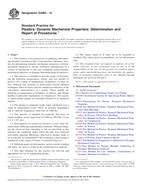Potřebujeme váš souhlas k využití jednotlivých dat, aby se vám mimo jiné mohly ukazovat informace týkající se vašich zájmů. Souhlas udělíte kliknutím na tlačítko „OK“.
ASTM D4065-12
Standard Practice for Plastics: Dynamic Mechanical Properties: Determination and Report of Procedures
Automaticky přeložený název:
Standardní praktiky pro Plasty: dynamických mechanických vlastností: Stanovení a Zpráva o postupech
NORMA vydána dne 1.8.2012
Informace o normě:
Označení normy: ASTM D4065-12
Poznámka: NEPLATNÁ
Datum vydání normy: 1.8.2012
Kód zboží: NS-25909
Počet stran: 7
Přibližná hmotnost: 21 g (0.05 liber)
Země: Americká technická norma
Kategorie: Technické normy ASTM
Kategorie - podobné normy:
Anotace textu normy ASTM D4065-12 :
Keywords:
dynamic mechanical, modulus, rheological, tan delta, viscoelastic, ICS Number Code 83.080.01 (Plastics in general)
Doplňující informace
| Significance and Use | ||||||||||||||||||||||||||
|
5.1 Dynamic mechanical testing provides a method for determining elastic and loss moduli as a function of temperature, frequency or time, or both. A plot of the elastic modulus and loss modulus of material versus temperature provides a graphical representation of elasticity and damping as a function of temperature or frequency. 5.2 This procedure can be used to locate transition temperatures of plastics, that is, changes in the molecular motions of a polymer. In the temperature ranges where significant changes occur, elastic modulus decreases rapidly with increasing temperature (at constant or near constant frequency) or increases with increasing frequency (at constant temperature). A maximum is observed for the loss modulus, as well as for the tan delta curve, in the transition region. 5.3 This procedure can be used, for example, to evaluate by comparison to known reference materials or control materials: 5.3.1 Degree of phase separation in multicomponent systems, 5.3.2 Filler type, amount, pretreatment, and dispersion, and 5.3.3 Effects of certain processing treatment. 5.4 This procedure can be used to determine the following: 5.4.1 Stiffness of polymer composites, especially as a function of temperature, 5.4.2 Degree of polymer crystallinity, and 5.4.3 Magnitude of triaxial stress state in the rubber phase of rubber modified polymers. 5.5 This procedure is useful for quality control, specification acceptance, and research. 5.6 Procedural modifications in material specifications take precedence to this practice. Therefore, consult the appropriate material specification before using this practice. Table 1 of Classification System D4000 lists the ASTM materials standards that currently exist. |
||||||||||||||||||||||||||
| 1. Scope | ||||||||||||||||||||||||||
|
1.1 This practice is for general use in gathering and reporting dynamic mechanical data. It incorporates laboratory practice for determining dynamic mechanical properties of plastic specimens subjected to various oscillatory deformations on a variety of instruments of the type commonly called dynamic mechanical analyzers or dynamic thermomechanical analyzers. 1.2 This practice is intended to provide means of determining the transition temperatures, elastic, and loss moduli of plastics over a range of temperatures, frequencies, or time, by free vibration and resonant or nonresonant forced vibration techniques. Plots of elastic and loss moduli are indicative of the viscoelastic characteristics of a plastic. These moduli are functions of temperature or frequency in plastics, and change rapidly at particular temperatures or frequencies. The regions of rapid moduli change are normally referred to as transition regions. 1.3 The practice is primarily useful when conducted over a range of temperatures from −160°C to polymer degradation and is valid for frequencies from 0.01 to 1000 Hz. 1.4 This practice is intended for materials that have an elastic modulus in the range from 0.5 MPa to 100 GPa (73 psi to 1.5 × 10 7 psi). 1.5 Discrepancies in results are known to arise when obtained under differing experimental conditions. Without changing the observed data, reporting in full (as described in this practice) the conditions under which the data were obtained will enable apparent differences observed in another study to be reconciled. An assumption of this technique is that testing is conducted in the region of linear viscoelastic behavior. 1.6 Different modes of deformation, such as tensile, bending and shear, are used, as listed in the referenced test methods. 1.7 Test data obtained by this practice are relevant and appropriate for use in engineering design. 1.8 The values stated in SI units are to be regarded as standard. The values given in parentheses are for information only. 1.9 This standard does not
purport to address all of the safety concerns, if any, associated
with its use. It is the responsibility of the user of this practice
to establish appropriate safety and health practices and determine
the applicability of regulatory limitations prior to use.
Standard Practice for Conditioning
Plastics for Testing Standard Terminology for Plastics:
Dynamic Mechanical Properties Standard Test Method for Loss Modulus
Conformance of Dynamic Mechanical Analyzers ISO 6721–1 Plastics-- Determination of Dynamic
Mechanical Properties, Part 1, General Principles Available from
American National Standards Institute, 25 W. 43rd St., New York, NY
10036. Standard Classification System for
Specifying Plastic Materials Standard Test Method for Plastics:
Dynamic Mechanical Properties Melt Rheology Standard Test Method for Plastics:
Dynamic Mechanical Properties: In Flexure (Three-Point Bending) Standard Test Method for Plastics:
Dynamic Mechanical Properties: In Compression Standard Test Method for Plastics:
Dynamic Mechanical Properties: In Tension Standard Test Method for Plastics:
Dynamic Mechanical Properties: In Torsion Standard Test Method for Plastics:
Dynamic Mechanical Properties: In Flexure (Dual Cantilever
Beam) Standard Test Methods for Temperature
Calibration of Dynamic Mechanical Analyzers Standard Test Method for Storage Modulus
Calibration of Dynamic Mechanical Analyzers |
Doporučujeme:
Aktualizace zákonů
Chcete mít jistotu o platnosti užívaných předpisů?
Nabízíme Vám řešení, abyste mohli používat stále platné (aktuální) legislativní předpisy.
Chcete vědět více informací? Podívejte se na tuto stránku.




 Cookies
Cookies
